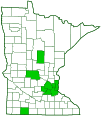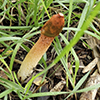Devil’s Stinkhorn
(Phallus rubicundus)
Conservation • Description • Habitat • Ecology • Distribution • Taxonomy
|
|
||||||||||||||
Description |
Devil’s Stinkhorn is native to the subtropical region of northern Africa, Australia, South America, northern Mexico and southern United States. It has spread throughout the eastern United States, probably in wood chip mulch imported from those regions. It is now common east of the Great Plains. It is found from spring through summer in lawns and gardens, especially where wood chip mulch is used. It grows on the ground, in wood chips or sawdust piles, singly or in groups. It is saprobic, obtaining its nutrients from decaying wood. The fruiting body at first is whitish to pale brown, egg-shaped, ¾″ to 1¼″ tall, and ⅜″ to 1¼″ wide. It resembles a puffball at least partially submerged in the ground. It is attached to the ground or other substrate by thread-like, branching, similarly colored strands (mycelium). Inside the “egg” there is a gelatinous layer, an olive-green spore mass (gleba), and all of the fully-formed parts of the mature stinkhorn. When conditions are right the “egg” ruptures and expands rapidly. In one or two days it produces a distinctly phallic structure with a stalk and thimble-like head. The rapid expansion is possible because all of the parts are fully formed and compressed inside the “egg”, and because the individual cells elongate, rather than new cells being produced. As the stinkhorn expands the gelatinous layer mixes with the spore mass producing a shiny, putrid slime that covers the cap. The foul-smelling slime is irresistible to flies, which feed on it, lay their eggs in it, and transfer spores when they fly to other stinkhorns. The stalk is hollow, spike-like, 6″ to 8″ tall, and about ⅝″ in diameter. It is widest at the base and tapers to the tip. It is bright orangish-red near the tip, fading to pale orange near the base. The surface is covered with irregular, pit-like depressions. The cap is thimble-like,1¼″to 1¾″ in height, and ⅝″ to ¾″ in diameter. There is an orangish-red, circular opening at the top where it attaches to the stalk. There are sometimes remnants of a membranous veil attached to the bottom of the cap. At first, the cap is covered with a thick, slimy or gluey, shiny, olive-green to olive-brown, spore-bearing mass (gleba). The gleba has a strong, putrid odor, repulsive to humans but irresistible to flies. When it is carried off by flies and/or washed off by rain it reveals an orangish-red, smooth, not pitted or ridged surface. There are no gills. |
Similar Species |
Habitat and Hosts |
Wood chip mulch, lawns, and gardens |
Ecology |
Season |
Spring through summer |
Distribution |
||
|
Sources |
|
| 8/26/2024 | ||
Occurrence |
||
Common and widespread east of the Great Plains |
||
Taxonomy |
|
Kingdom |
Fungi (Fungi) |
Subkingdom |
Dikarya |
Phylum |
Basidiomycota (Basidiomycete Fungi) |
Subphylum |
Agaricomycotina (Higher Basidiomycetes) |
Class |
Agaricomycetes (Mushrooms, Bracket Fungi, Puffballs, and Allies) |
Subclass |
Phallomycetidae |
Order |
Phallales (stinkhorns and allies) |
Family |
Phallaceae (stinkhorns) |
Genus |
Phallus |
Subordinate Taxa |
|
|
|
Synonyms |
|
Ithyphallus rubicundus Leiophallus rubicundus Satyrus rubicundus |
|
Common Names |
|
Devil’s Stinkhorn |
|
Glossary
Gleba
The inner spore-bearing mass of puffballs, earthstars, and stinkhorns. The term is also used to refer to the spore-bearing slime covering the head of a stinkhorn.
Mycelium
The vegetative part of a fungus; consisting of a mass of branching, thread-like hyphae, through which a fungus absorbs nutrients from its environment; and excluding the fruiting, reproductive structure.
Saprobic
A term often used for saprotrophic fungi. Referring to fungi that obtain their nutrients from decayed organic matter.
Visitor Photos |
||
Share your photo of this fungus. |
||
This button not working for you? |
||
Melissa Eggerth |
||
 |
||
Sarah W. |
||
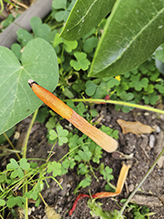 |
||
Found a small trio in my garden. I had never seen this fungus before today. |
||
E. Russell |
||
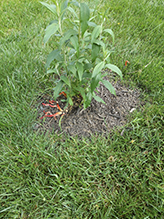 |
||
Found in the mulch at the base of a Butterfly Bush in my backyard. |
||
Melissa Alberts |
||
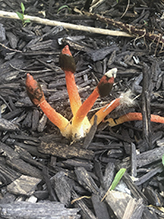 |
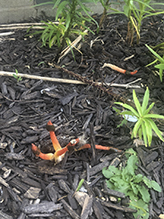 |
|
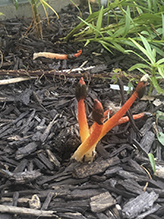 |
||
ABaker |
||
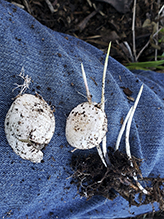 |
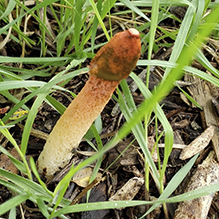 |
|
In July I wast digging around by my mulch pile when I smelled something really bad. I found these unusual (to me) pods in my wood chips. … |
… About a month later, these guys were poking their heads out all over the place. | |
Ms. Perkins |
||
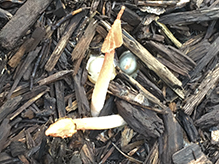 |
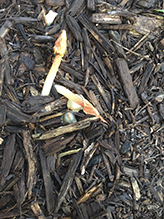 |
|
At first glance I thought this was a foam dart from one my son's Nerf guns. Good thing I didn't try to pick it up, my hands would have stunk for a week! |
||
Luciearl |
||
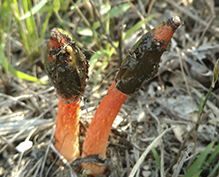 |
||
My first thought was these looked like bright orange cables coming from the ground. A closer look showed Devil's Stinkhorn. |
||
LizInMpls |
||
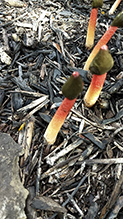 |
||
MinnesotaSeasons.com Photos |
||

Slideshows |
|

Visitor Videos |
||
Share your video of this fungus. |
||
This button not working for you? |
||
|
Other Videos |
||
The Phallus Mushroom and Friends |
About
Published on Oct 24, 2016 |
Phallus rubicundus (Devil's Stinkhorn) |
About
Published on Sep 11, 2013 |

Visitor Sightings |
||
Report a sighting of this fungus. |
||
This button not working for you? |
||
Melissa Eggerth |
Location: Little Falls MN |
 |
| Sarah W. 9/11/2023 |
Location: St. Paul Found a small trio in my garden. I had never seen this fungus before today. |
 |
| E. Russell 5/17/2023 |
Location: Blount County, TN Found in the mulch at the base of a Butterfly Bush in my backyard. |
 |
Barbara Pakay |
Location: Russellville Arkansas |
| ABaker 8/13/2020 |
Location: Kimball, MN Stearns County I found these unusual (to me) pods in my wood chips. About a month later, these guys were poking their heads out all over the place. |
| Melissa Alberts 7/27/2021 |
Location: Jackson MN – flowerbed around my house |
 |
| ABaker 7/19/2020 |
Location: Kimball, MN Stearns County In July I wast digging around by my mulch pile when I smelled something really bad. |
M and D Crane |
Location: SW Minneapolis |
|
| Ms. Perkins 7/16/2019 |
Location: Brooklyn Center At first glance I thought this was a foam dart from one my son's Nerf guns. Good thing I didn't try to pick it up, my hands would have stunk for a week! |
Teri |
Location: Fridley backyard |
|
| Luciearl 9/2017 |
Location: Paul Bunyan Trail, Nisswa My first thought was these looked like bright orange cables coming from the ground. A closer look showed Devil's Stinkhorn. |
| LizInMpls 8/30/2018 |
Location: Hennepin - South Minneapolis |
MinnesotaSeasons.com Sightings |
||
|

Created: 9/2/2018 Last Updated: © MinnesotaSeasons.com. All rights reserved. |
